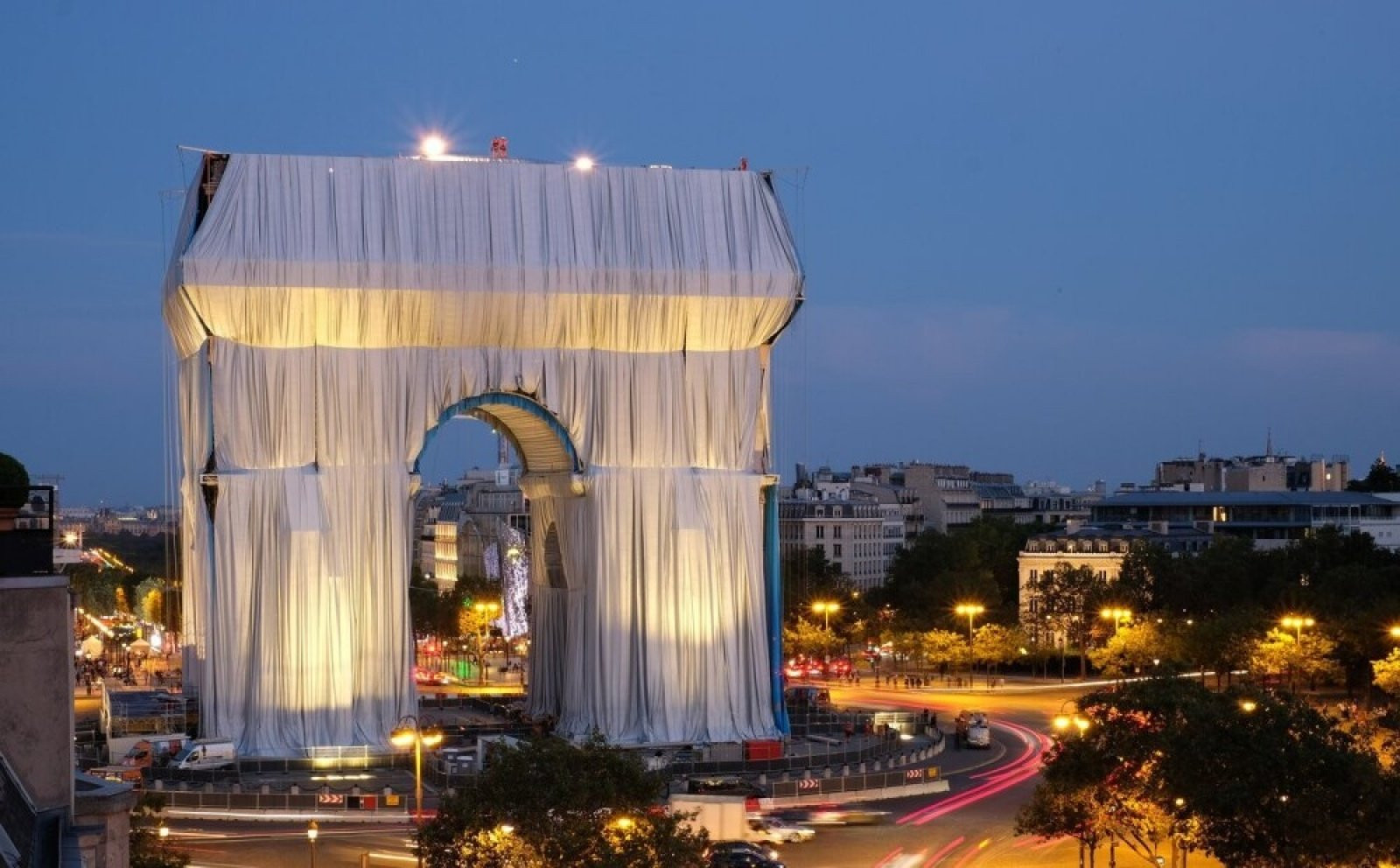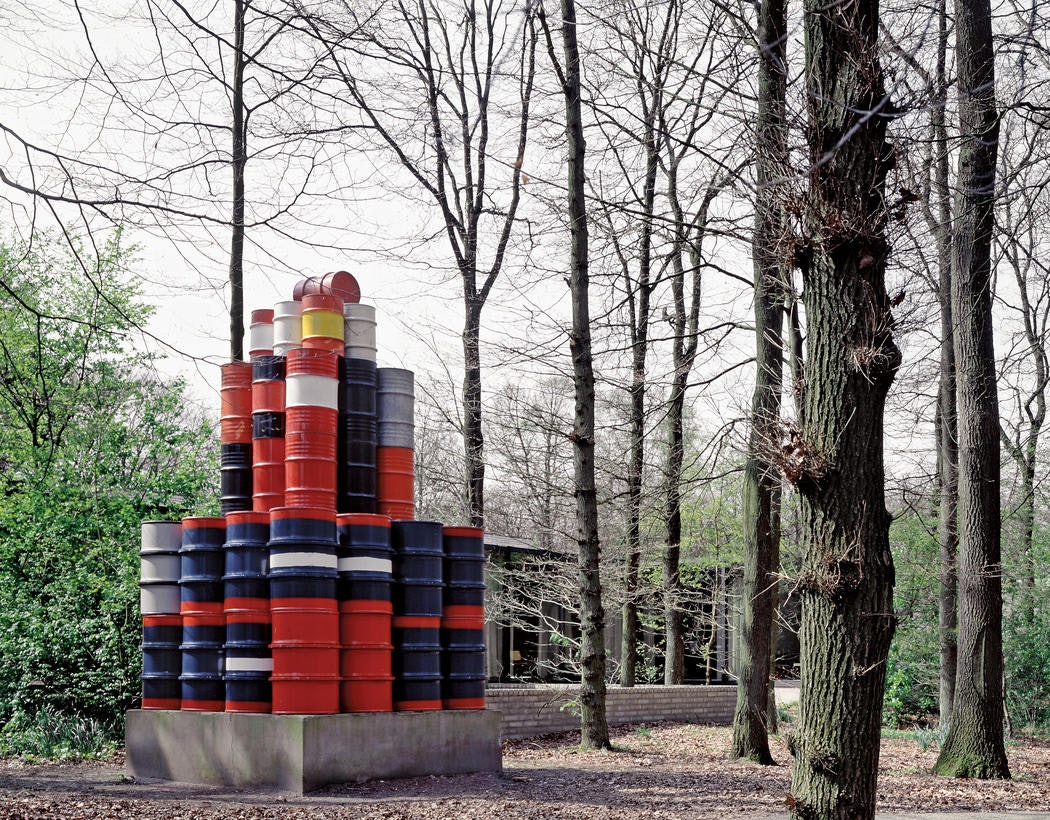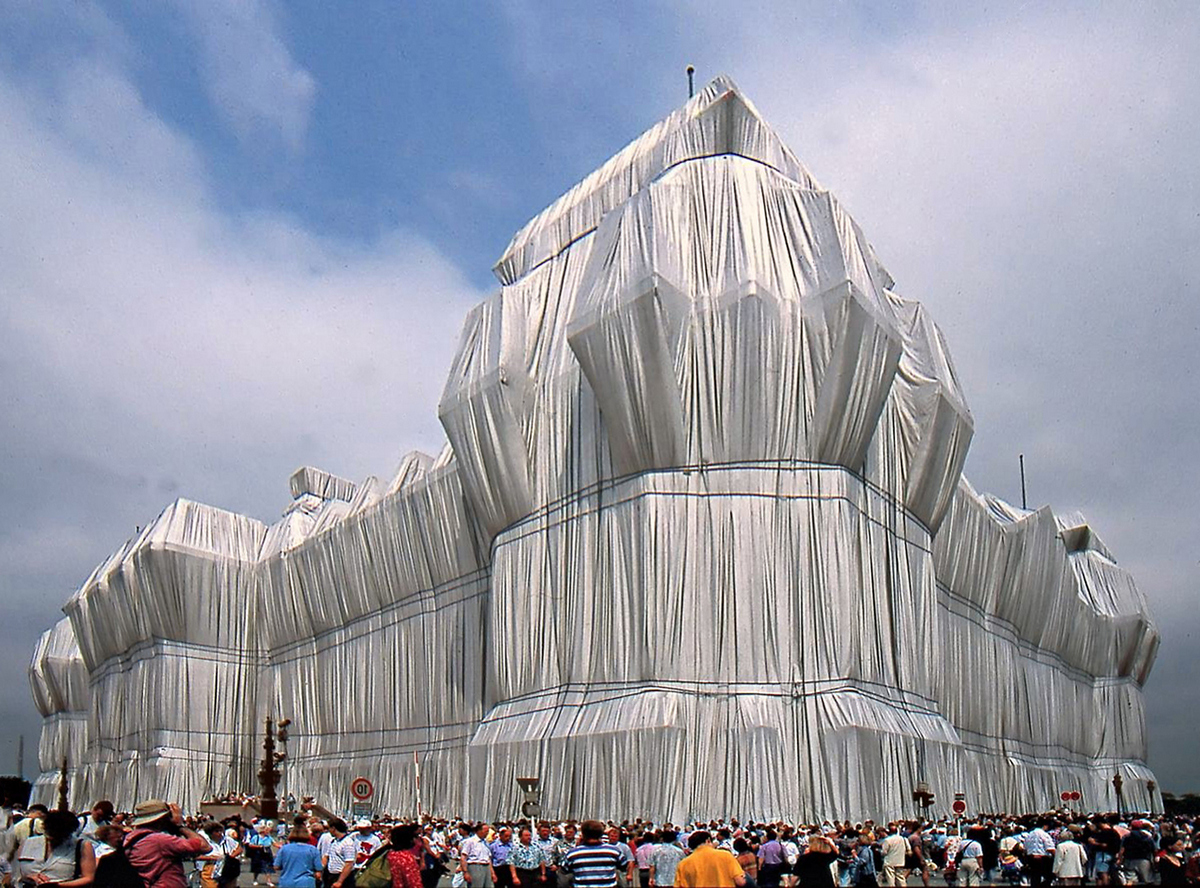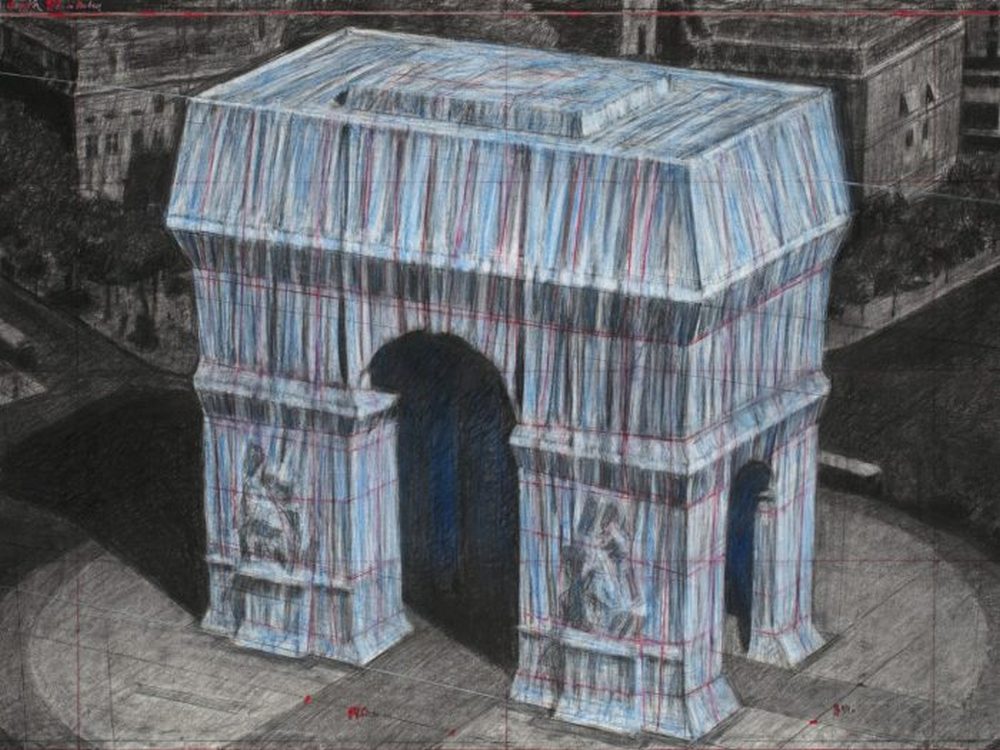

In September this year, the media reported implementing an unusual art project. According to the last will of the conceptual artist Christo Javacheff, the Arc de Triomphe in Paris was to be wrapped in cloth and tied with ropes. Outwardly, all this resembled the packaging of an architectural monument with an unclear purpose. The network even suggested that in this way, the memorial of the French capital is planned to be closed for restoration or to prevent the destruction of sculptures and bas-reliefs located on the facade. As it turned out later, all these versions were far from the truth, and the project itself resulted from a long creative search and negotiations with the municipal authorities. The installation "Wrapped Arc de Triomphe" was created decades after the first sketches were made. The appearance of such an unusual art object became possible after a long creative search and implementation of similar projects worldwide.
Life and work of Christo Javacheff and Jeanne-Claude Denat de Guillebon
The future sculptor and artist were born in 1935 in Bulgaria. After studying at the Sofia Academy of Arts, he illegally emigrated to Austria and France. In Paris in 1958, he met Jeanne-Claude Denat de Guillebon, with whom he was born on the same day. They soon married and created their first oil barrel project. Over the next 50 years, Christo and Jeanne-Claude worked on various projects and became world-famous creators of large-scale temporary land art. They raised funds to implement their ideas by selling paintings, sketches, and other art objects. Christo and Jeanne-Claude worked in the direction of conceptualism. The desire to free the viewer's gaze from distracting details and texture led them to the idea of packaging objects. At first, it was small cans and other things, and then they moved on to creating installations and land art.

Christo Vladimirov Javacheff and Jeanne-Claude Denat de Guillebon. Photos © birdinflight.com
Christo considered himself a Marxist, but this did not prevent him and his wife from finding astonishing amounts of money to implement monumental art objects. In 2009, Christo was widowed and continued to work on the projects planned with Jeanne-Claude until he died in 2020. The couple's work traces the environmental themes typical of all leftist artists. Christo and Jeanne-Claude created some projects to draw attention to environmental issues. All land arts were built as temporary objects with free access.
The path to triumph
Throughout their lives, Christo and Jeanne-Claude have realized dozens of large land arts within the city, rivers, mountains, fields, and coastal islands. The geographical breadth of coverage is impressive: the artists created their works in Europe, the USA, Australia, and Asia. Implementation of most projects became possible only after lengthy negotiations with local authorities. Because of this, they sometimes lasted for decades, and only sometimes all ended with permission. Christo and Jeanne-Claude had to explain carefully the real reason for their desire to wrap bridges, statues, and entire buildings in the monochromatic matter. For this reason, only 23 projects have been realized in 60 years of work.
Wall of oil barrels
A series of installations were presented to the public between 1961 and 1962. From a technical point of view, the installations were quite simple - from oil barrels wrapped in cloth, artists laid out obstacles on the streets in different cities. This experience was the first step toward the monumental works of a more mature period.

«Wall of oil barrels» Christo Vladimirov Javacheff and Jeanne-Claude Denat de Guillebon. Photos © birdinflight.com
The most widely publicized projects were in Cologne and Paris. For obvious reasons, the municipal authorities did not like such obstacles, so the attitude to the artists' work was negative. But thanks to such conflicts, Christo and Jeanne-Claude quickly gained fame and glory among the European avant-garde.
With the help of installations, they tried to draw public attention to the problem of restrictions on freedom of movement in Europe after the occupation of several countries by Soviet troops and the construction of the Berlin Wall. In addition, the artists could realize the idea of spatial reconfiguration with an object that is not contextually connected with the environment. The walls made of oil barrels marked an essential turn in Christo Javacheff's work - it received a new scale. Around the same time, the artist desired to take on more serious projects, including the Arc de Triomphe in Paris. Such ideas in France at that time did not find support from the authorities, so the project had to be postponed to a later period.
Wrapped shore
In search of new horizons, the master wrapped 1.5 miles of the coastal zone in Little Bay near Sydney in the late 60s. At that time, it was the most monumental work of art, exceeding the size of the bas-relief on Mount Rushmore. For ten weeks, visitors had the opportunity to rediscover the rocky coastline, focusing on the pure geometric shapes of the area. In this project, the form and structure of the coastline revealed themselves in its entirety.
The curtain of the valley
Continuing to experiment with objects of natural origin, Christo and his wife create a giant crescent-shaped curtain of orange nylon between the Grand Junction and Glenwood Springs mountains in the Hogback Range. It was not the first time the art object was installed. In October 1971, strong gusts of wind disrupted all plans for the installation and then had to wait until August 1972. Due to the high wind, the installed curtain stood intact for only 28 hours. Despite its short existence, the art object managed to get on film and photographs.
Wrapped Reichstag
The famous government building became part of the installation of Christo and Jeanne-Claude in 1995. Before that, the artists spent more than 20 years lobbying for the project and convincing the German government that all this would not harm Germany's reputation. It even reached the point that the project was put to the vote in parliament. And as a result, the artists managed to get permission, and they started to work. In total, about 200 tons of steel were used for the substructure that followed the contours of the building, 15.6 thousand meters of propylene rope, and 100 thousand square meters of polypropylene fabric. According to the project's authors, it was supposed to demonstrate the progressive thinking of Berliners and openness to new aesthetic ideas. During two weeks of existence, the project was viewed by about 5 million visitors.

«Wrapped Reichstag» Christo Vladimirov Javacheff and Jeanne-Claude Denat de Guillebon. Photos © artifex.ru
Among other exciting projects, it is also worth mentioning Mastaba in Hyde Park, made of oil barrels wrapped in golden fabric Pont Neuf bridge in Paris, surrounded by islands in the Bay of Biscayne in Florida. All these land arts attracted the attention of millions of visitors and well-known publications specializing in contemporary art. But there was one project that Christo and Jeanne-Claude should have realized for decades. It was destined to break the records of Pont Neuf and the Reichstag.
"Arc de Triomphe wrapped"
Unfortunately, the project in Paris became the longest in Christo's career, which was realized after his death. It took 60 years from the first sketch to the presentation of the finished installation! It is said that during the first two years, the couple made many collages and sketches of the future project but still needed to proceed to actual actions due to the lack of agreements with the authorities. Only in early 2020 where all the necessary permits obtained, but no one was to implement them. After Christo's death, his nephew Volodymyr Javacheff took the initiative. According to him, in this way, he fulfilled the last will of his uncle and put an end to the creative activity of the famous couple. Ironically, the project had to be postponed because of the fire in Notre Dame Cathedral. Falcons nested on its roof and flew to the Arc de Triomphe, making the task impossible. If not for this sad incident, Christo would have been able to see the wrapped arch with his own eyes.

«Arc de Triomphe wrapped» Christo Vladimirov Javacheff and Jeanne-Claude Denat de Guillebon. Photos © artandyou.ru
In close cooperation with the Pompidou Center, Volodymyr implemented the project with the help of 25 thousand square meters of bluish-silver polypropylene produced by the German company Geo - Die Luftwerker. Due to the enormous weight (600 kg per square meter), the material was delivered to the construction site in large rolls by crane. Some of the 18 weighed more than a ton with a size of 16 by 52 meters. It took about seven months to prepare: the canvases were sewn and cut by sewists. About 14 million euros were spent on the project, received through the sale of works of art and sketches of Christo and Jeanne-Claude. The official opening took place on September 18 this year.
The stretched fabric reflects the sun's rays, creating an interesting optical effect. As in other similar projects, the wrapping helps the viewer abstract from the small details on the facade of the architectural monument and fully experience the pleasure of pure form. Unfortunately, visitors will only have the opportunity to see the installation with their own eyes until October 3, 2021. After that, all the fabric will be removed and disposed of according to the plan. For the installation of metal structures, about 200 holes were drilled in the facade under the supervision of monument protection specialists, which will be putty after the installation is completed. For Christo and Jeanne-Claude, the project implementation became a kind of passage under the Arc de Triomphe, even if posthumous.
KyivGallery art critic
